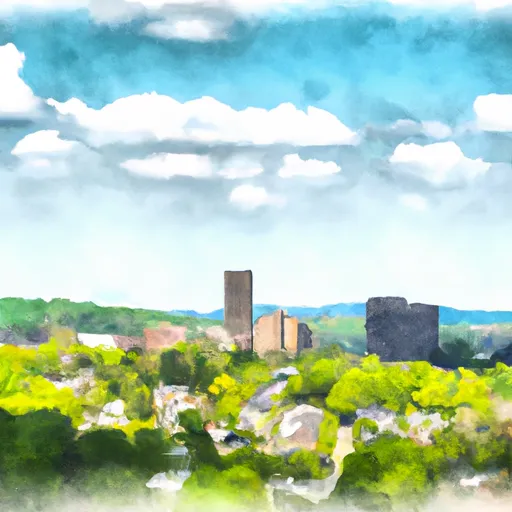-
 Snoflo Premium
Snoflo Premium
Get unlimited access to all our content
With no Ad interruptions! - Start Your Free Trial Login with existing account
Level-Green
Eden Index
Climate
8.2
•
Recreation
3.2
•
Community
3.3
•
Safeguard
5.2/10

Level-Green, Pennsylvania is a charming community located in Allegheny County, known for its diverse climate and stunning natural beauty. The region experiences a humid continental climate, characterized by warm summers and cold winters. Average temperatures range from the mid-20s in winter to the mid-80s in summer, offering a pleasant variety throughout the year.
Hydrologically, Level-Green is situated near the serene Turtle Creek, a tributary of the Monongahela River. This waterway not only enhances the scenic beauty of the area but also supports various outdoor activities like fishing, kayaking, and canoeing. The creek is home to a variety of fish species, including trout and bass, offering excellent angling opportunities for fishing enthusiasts.
The surrounding area also boasts numerous outdoor recreation opportunities. Nearby parks and green spaces provide ample opportunities for hiking, biking, and picnicking. The scenic rolling hills and picturesque landscapes make for an ideal backdrop for outdoor adventures. Additionally, the close proximity to the Laurel Highlands offers access to hiking trails, camping sites, and winter sports activities such as skiing and snowboarding.
Level-Green, Pennsylvania truly offers a rich natural environment, making it a haven for outdoor enthusiasts seeking both tranquil moments and thrilling adventures.
What is the Eden Index?
The Snoflo Eden Index serves as a comprehensive rating system for regions, evaluating their desirability through a holistic assessment of climate health, outdoor recreation opportunities, and natural disaster risk, acknowledging the profound impact of these factors on livability and well-being.
Climate Health Indicator (CHI): 8.2
Level-Green receives approximately
1035mm of rain per year,
with humidity levels near 83%
and air temperatures averaging around
11°C.
Level-Green has a plant hardyness factor of
6, meaning
plants and agriculture in this region thrive during a short period during spring and early summer. Most
plants will die off during the colder winter months.
By considering the ideal temperature range, reliable water supplies, clean air, and stable seasonal rain or snowpacks, the Climate Health Indicator (CHI) underscores the significance of a healthy climate as the foundation for quality living.
A healthy climate is paramount for ensuring a high quality of life and livability in a region, fostering both physical well-being and environmental harmony. This can be characterized by ideal temperatures, reliable access to water supplies, clean air, and consistent seasonal rain or snowpacks.
Weather Forecast
Streamflow Conditions
Monongahela
Area Rivers
Monongahela
Snowpack Depths
Monongahela
Reservoir Storage Capacity
Monongahela
Groundwater Levels
Recreational Opportunity Index (ROI): 3.2
The Recreational Opportunity Index (ROI) recognizes the value of outdoor recreational options, such as parks, hiking trails, camping sites, and fishing spots, while acknowledging that climate plays a pivotal role in ensuring the comfort and consistency of these experiences.
Access to outdoor recreational opportunities, encompassing activities such as parks, hiking, camping, and fishing, is crucial for overall well-being, and the climate plays a pivotal role in enabling and enhancing these experiences, ensuring that individuals can engage in nature-based activities comfortably and consistently.
Camping Areas
| Campground | Campsites | Reservations | Toilets | Showers | Elevation |
|---|---|---|---|---|---|
| Chestnut Ridge Regional Park | None | 2,268 ft | |||
| Two Mile Run County Park | None | 1,304 ft | |||
| Coopers Rock State Forest | None | 2,154 ft |
Nearby Fishing
Nearby Ski Areas
Catastrophe Safeguard Index (CSI):
The Catastrophe Safeguard Index (CSI) recognizes that natural disaster risk, encompassing floods, fires, hurricanes, and tornadoes, can drastically affect safety and the overall appeal of an area.
The level of natural disaster risk in a region significantly affects safety and the overall livability, with climate change amplifying these risks by potentially increasing the frequency and intensity of events like floods, fires, hurricanes, and tornadoes, thereby posing substantial challenges to community resilience and well-being.
Community Resilience Indicator (CRI): 3.3
The Community Resilience Indicator (CRI) recognizes that education, healthcare, and socioeconomics are crucial to the well-being of a region. The CRI acknowledges the profound impact of these elements on residents' overall quality of life. By evaluating educational resources, healthcare accessibility, and economic inclusivity, the index captures the essential aspects that contribute to a thriving community, fostering resident satisfaction, equity, and social cohesion.

